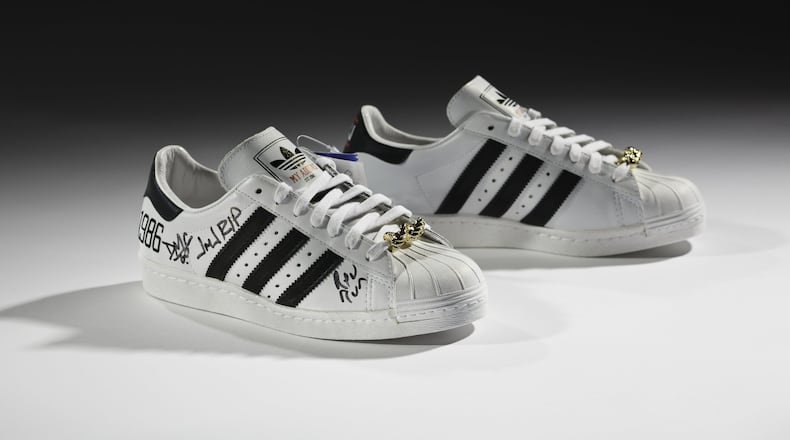EVENT PREVIEW
“The Rise of Sneaker Culture”
June 11-Aug. 14. The High Museum of Art calls it "the first museum exhibition in the United States to examine the complex and fascinating social history and design evolution of the sneaker." 10 a.m.-5 p.m. Tuesdays-Thursdays and Saturdays; 10 a.m.-9 p.m. Fridays; noon-5 p.m. Sundays. Adults, $19.50; seniors and students, $16.50; children 6-17, $12; children 5 and under, free. High Museum of Art, 1280 Peachtree St., Atlanta. 404-733-4400, high.org.
“We travel on gravel, dirt road or street
I wear my Adidas when I rock the beat
on stage front page every show I go
it’s Adidas on my feet high top or low.”
Run DMC: “My Adidas”
The sneaker.
Is there a more changeable signifier of American status?
Just like the vulcanized rubber that gives the sneaker life, its image and purpose are elastic, making the sneaker at different times a plaything of the leisure class, the uniform of the punk musician, a badge of street credibility, and a sign of the self-involved yuppie jogger.
The many lives of the humble athletic shoe will be examined in "The Rise of Sneaker Culture," a new exhibit opening Saturday at the High Museum of Art. The four-stop U.S. tour has also been hosted by the Brooklyn Museum and Ohio's Toledo Museum of Art, and it will appear at the Speed Art Museum in Louisville, Ky.
Created by Elizabeth Semmelhack, senior curator at the Bata Shoe Museum in Toronto, "The Rise of Sneaker Culture" shows off 150 pairs of shoes, and traces the sneaker from its beginnings in the rubber plantations of Brazil to the dance floor of Studio 54. An ancient pair of Chuck Taylors, the 100-year-old, once-and-future king of high-tops, will be displayed, alongside a fresh set of suede Puma creepers, blessed (and marketed) by Rihanna as the "it" shoe of 2015.
You can see more of the shoes here.
The High is no stranger to exhibits on fashion and design. The museum just wrapped up another fashion exhibit focusing on the designs of Dutch designer Iris van Herpen. Another High show, "Dream Cars," examined the art of automotive design.
Some of the shoes in “The Rise of Sneaker Culture” are drawn from the 13,000 artifacts at the Bata museum, but more are on loan from private collections and from the archives of manufacturers.
Among the rarities are the overshoes made from South American latex and imported into Europe in the 1820s, shoes that displayed the new, problematic technology of rubber. The uncured rubber shoes were waterproof, but fragile. They froze and cracked in the winter and melted in summer.
It wasn’t until the vulcanization process, developed by Charles Goodyear and others, made rubber more durable and flexible that rubber began to be used in hundreds of applications. Rubber then became, said Semmelhack (quoting an early Goodyear executive), “the sinew and muscle of the industrial age.”
During this time, the moneyed aristocracy could afford time off for lawn tennis — and the shoes to go with the sport. But tennis shoes wouldn’t remain a perk of the wealthy. “The sneaker lost its status in the period between World War I and World War II,” Semmelhack said.
In that period, Western nations stressed the need for physical fitness as a matter of national security. In Germany, crowds of young people put on exercise exhibitions. In the U.S., the spread of basketball pushed the producers of sneakers to bring costs down. “They became one of the most democratic forms of fashion worldwide,” Semmelhack said.
Democratic, yes. But sneakers have long benefited from reflected celebrity glory.
A few examples:
Adidas: The company was created by German track-and-field shoemaker Adi Dassler, who had connections to the Nazi party, but also outfitted Jesse Owens in the 1936 Olympics. Adidas sneakers were famously worn by basketball star Kareem Abdul-Jabbar and heralded by rap group Run DMC.
Chuck Taylors: In 1921, the Converse Rubber Shoe Co. added the basketball player Charles H. "Chuck" Taylor to its staff as a salesman. With improvements suggested by Taylor, and with his signature on the ankle, the Converse All-Star became an American icon, worn by Wilt Chamberlain and Joey Ramone.
Jack Purcell: How often do you hear of Canadian badminton celebrities? "We don't have so many of those now, but he (Jack Purcell) was well known at the time," Semmelhack said. Purcell, who was crowned world champion in 1933, designed the canvas and rubber court sneakers that were nicknamed "Smilies" for the distinctive blue "smile" on the toe. They are now appreciated more for their vintage appeal than their athletic advantages.
Celebrity endorsements notwithstanding, sneakers, until the 1970s, reigned as children’s wear. “It became the footwear of boyhood and summertime,” Semmelhack said. In his short story “The Sound of Summer Running,” Ray Bradbury created a symphonic tribute to the Cream-Sponge Para Litefoot sneaker that entrances the lead character, “shoes that were quiet as a summer rain falling on the walks.”
The subsequent decades sent the footwear through a twisty set of paces. Boy wonders in the tech industry boardroom made sneakers into business wear, while casual Fridays forced men to make the sorts of shoe choices usually inflicted only on women.
“You had to wear something that reveals something private about who you are on the weekend,” said Semmelhack. “Men were struggling like women always do.”
Semmelhack, 52, writes extensively about fashion, and confesses that she has lusted after a pair of blue Adidas Gazelles. Her sneaker show was first mounted at the Bata Shoe Museum in 2013 as “Out of the Box: The Rise of Sneaker Culture.”
RELATED: Noguchi sculpture finally comes home to High Museum
About the Author
Keep Reading
The Latest
Featured



